#Hemlock woolly adelgid
Link
June 28, 2022
The Canadian Council on Invasive Species (CCIS) gave a short presentation of the top 10 invasive species already in Canada or that could come to Canada from south of our border and that we therefore should be on the alert for.
The top 10 invasive species were as follows:
Asian long-horned beetle, Anoplophora glabripennis
Spotted lanternfly, Lycorma delicatula
Asian giant hornet, Vespa mandarinia
Emerald ash borer, Agrilus planipennis
Hemlock woolly adelgid, Adelges tsugae
Brown marmorated stink bug, Halyomorpha halys
Dutch elm disease, Ophiostoma ulmi and Ophiostoma novo-ulmi
Japanese beetle, Popillia japonica
Spongy moth (also LDD moth; previously gypsy moth), Lymantria dispar dispar
Lily leaf beetle, Lilioceris lilii
I have definitely seen at least three of these species and/or the damage they have done, specifically 4, 8, and 9.
You can help by reporting these species through, for example, iNaturalist. CCIS has their own project on iNaturalist, titled “I Spy and Identify Invasives / Je vois, J’identifie les espèces envahissantes”, which you can join: https://www.inaturalist.org/projects/i-spy-and-identify-invasives-je-vois-j-identifie-les-especes-envahissantes. The CCIS also has a whole webpage on how and where to report: https://canadainvasives.ca/take-action/report/.
#wildflowers of southern ontario#invasive species#canada#Canadian Council on Invasive Species#inaturalist#Asian long-horned beetle#Anoplophora glabripennis#Spotted lanternfly#Lycorma delicatula#Asian giant hornet#Vespa mandarinia#Emerald ash borer#Agrilus planipennis#Hemlock woolly adelgid#Adelges tsugae#Brown marmorated stink bug#Halyomorpha halys#Dutch elm disease#Ophiostoma ulmi#Ophiostoma novo-ulmi#Japanese beetle#Popillia japonica#Spongy moth#LDD moth#Lymantria dispar#Lymantria dispar dispar#Lily leaf beetle#Lilioceris lilii
12 notes
·
View notes
Text
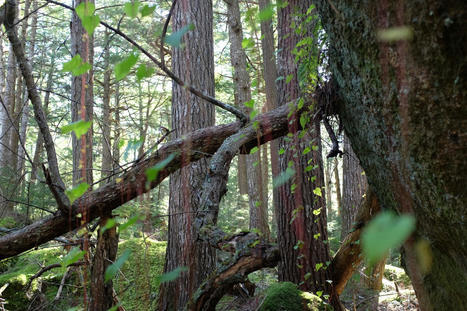
Combatting Hemlock Woolly Adelgid Infestations with NS Tree Preservation Co.
Discover the expert solutions of NS Tree Preservation Co. in safeguarding your hemlock trees from the destructive Hemlock Woolly Adelgid. Our experienced arborists employ advanced techniques to assess, treat, and prevent infestations, ensuring the health and longevity of your precious hemlocks. Trust us to preserve the beauty and vitality of your landscape with our specialized Hemlock Woolly Adelgid control services. Contact Us: 9028757686 | [email protected]
0 notes
Text
The Hemlock Woolly Adelgid: Spotlight on an Invasive Species of Pennsylvania
In the fourth installment of our series on invasive species of insects, we will discuss the hemlock woolly adelgid. The hemlock woolly adelgid (HWA, or adelges tsugae) is a tiny, sap-sucking insect native to East Asia. Recognized as an invasive species in the United States, the pest has been identified in multiple states and was found in Pennsylvania in the late 1960s. The HWA is a significant threat to eastern hemlock trees, the state tree of Pennsylvania.
As plant health care professionals, we want to help you and other Pennsylvania residents understand the impact of this invasive pest and keep your hemlock trees safe. Below, we discuss the characteristics, life cycle, damage and treatment of hemlock woolly adelgid in Pennsylvania.

Identifying the Hemlock Woolly Adelgid
Adelgids are a small family of insects closely related to aphids that feed on the plant sap of conifer trees and, in the hemlock woolly adelgid’s case, hemlock and spruce trees. The insect measures less than 1/16 inch (1.5mm) and is covered in a wool-like wax filament, giving the pest a “cottony” appearance. Females are black, oval, soft-bodied, and about 1.5 mm long. HWA is primarily found on the underside of hemlocks’ branches, nestled against the base of the needles.
The Life Cycle of the HWA
The hemlock woolly adelgid possesses an intricate two-year life cycle, encompassing four immature stages and culminating in a reproductive adult phase. Throughout late winter and early spring, as temperatures climb, adult female HWAs begin laying eggs. These clusters of eggs, housed within white filamentous wax masses, continue to be laid until June. Measuring 0.25 mm in length and 0.15 mm in width, the oblong eggs have a brownish-orange color. Depending on the warmth of the spring season, hatching starts in early April and typically concludes by the end of June.
Emerging as reddish-brown nymphs, or “crawlers,” these young insects display a delicate white fringe near their anterior. Once settled, crawlers grow to approximately 0.3 mm long, and take on a black hue with a white fringe that encircles their bodies and extends along their dorsal side. As these nymphs develop, their color deepens to a dark reddish-brown, and their size progressively increases due to active feeding habits. By late September, these mature female insects reside on trees, overwintering before repeating the reproductive process of the species.
Recognizing an Infestation
The most apparent sign of HWA infestation is the white, “cottony” egg sacs on the underside of hemlock branches that the females produce when laying eggs. These egg sacs look much like the tip of a cotton swab and typically persist even after the insects are dead. Other signs include needle loss, reduced twig growth, and dieback of branches.
Damage Caused by Hemlock Woolly Adelgid
The impact of an HWA infestation on eastern hemlock trees can be catastrophic to the tree, depending on the extent of the infestation. The adelgids use sharp, syringe-like mouthparts, or stylets, to siphon off essential plant fluids from host plants. This feeding activity takes a toll on the plant’s overall health.
A moderate population of the hemlock woolly adelgid may lead to a noticeable decline in the health and vigor of your trees. However, the consequences become more serious in a severe infestation. This could result in a premature shedding of needles, diminished growth of twigs, significant dieback, and in worst cases, the loss of the tree. This danger to the trees makes early detection and decisive action in managing these unwelcome pests important.
Managing & Controlling Hemlock Woolly Adelgid
We are often asked to manage this pest in late September through October. We use several methods for managing infestations of hemlock woolly adelgid.
Insecticides
Registered systemic insecticides applied in late September and October can reduce hemlock woolly adelgid populations and temporarily prevent the establishment of new infestations for up to seven years. These systemic insecticides are usually injected into tree trunks or applied as a soil drench or injection. These insecticides often target overwintering females.
A plant health care expert can also apply sprays during other times of the year. A mid-to-late June spray may help reduce the number of developing nymphs. This management strategy is appropriate when thorough coverage is difficult to achieve using ground application equipment. Early spring soil injections usually work well against this pest when the soil is sufficiently irrigated.
Biological Control
Predatory insects can also be used to control HWA populations. The species most commonly used for this application are Laricobius nigrinus, a beetle native to the western United States, and Sasajiscymnus tsugae, a beetle native to Japan. Both beetle species are attracted to the white woolly egg masses that HWA produces. In addition, the beetles feed on the HWA, and their larvae also feed on the pest.
While most often used in forests, this method is becoming more common for residential hemlock trees in the United States. This is because biological controls to remove species of harmful pests can be a more environmentally friendly method of control than using chemicals. As with insecticides, a qualified arborist should perform this treatment. A certified arborist can help you assess the severity of the infestation and recommend the best course of action.
Contact Burkholder PHC for Hemlock Woolly Adelgid Treatment in Your Landscape
If you suspect or are concerned about the presence of hemlock woolly adelgid on your property, contact Burkholder PHC for expert advice and treatment options. We provide a free evaluation by our highly experienced, qualified plant health care experts and certified arborists to help remove and control invasive species and the adverse effects these pests cause. Contact Burkholder PHC today for a free consultation.
Blog is originally published at: https://www.burkholderphc.com/the-hemlock-woolly-adelgid-spotlight-on-an-invasive-species-of-pennsylvania/
It is republished with the permission from the author.
0 notes
Text



Our final stop was the Joyce Kilmer Memorial Forest, a protected tract of old growth and some of the biggest trees I have ever seen in person. We were trying to figure out why so much of the old growth was sadly dead, disproportionately so in comparison to just regular deadfall, so I did some digging and it is.. unfortunately mostly more dead eastern hemlock, killed by the woolly adelgid.
Regardless, the forest was still a beautiful hike and I could have laid down in all the ferns and mushrooms and just never got back up. Just leave me. It's fine. It's a spot I would definitely like to return to though. I also got back in my default comfort zone with macro photography (coming soon).
21 notes
·
View notes
Text
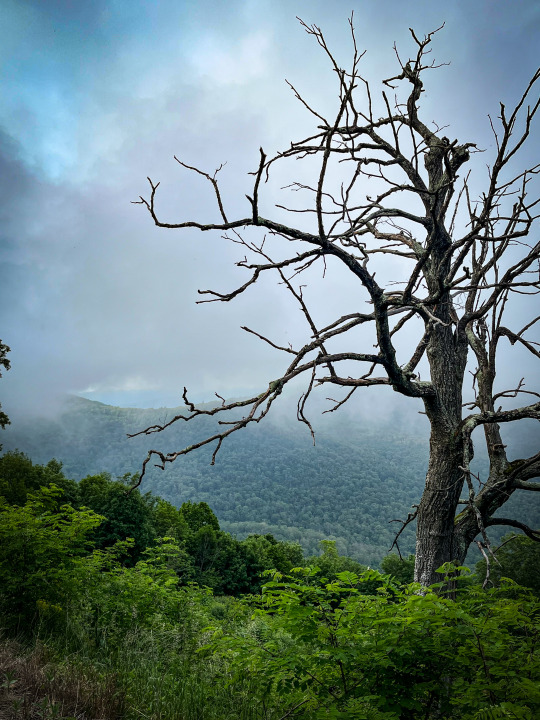
Hemlock Springs Overlook - Shenandoah National Park - June 2022
Nearly all of the Eastern Hemlocks in Shenandoah National Park were killed by an invasive pest called the hemlock woolly adelgid. This is one of the victims.
12 notes
·
View notes
Note
random OC ask (for siobhan): if your OC was in a modern!AU, what would their job be? what would their day-to-day life look like? would they be very similar to their canon conception, or different?
(the modern!AU can be in the fashion of your favored iteration, whether that is a 1:1 version of our universe, modern-with-magic, etc.)
I think my Modern AU would be modern with magic but adventuring is a rarer occupation that it was in the past. Most people still have a class and such but it’s used mostly for the mundane not high adventure. The desire for adventure still exists but most people are able to sate it by going out of town for a weekend and killing a gnoll in a ditch next to the interstate. The world is still fantasy dangerous but most people stay in the cities since it’s safer. Baldur’s Gate exists pretty much as is on the sword coast with the addition of most modern tech and maybe some governmental changes.
With that out of the way, assuming nothing that would cause her to become the main character of a video game happens, Siobhan would live relatively simply. Since she’s a spores druid I think she would work for the fantasy forest service cataloguing the health of wilderness areas outside the city walls. Looking for serious health risks in animal populations and new diseases and parasites in plants. Professionally she’d be dealing with all the dead things and would be very capable defending herself from living things. Personally, she would care a lot about colony collapse disorder and the hemlock woolly adelgid. She would yell at you for transporting firewood across state lines.
Personality wise she’d be pretty much the same, her canon was my first playthrough so she was the logical avatar, moving through the story with curiosity and trying to do the right thing and make friends. Given that there’s no video game plot I think she’d wonder if there was anything else out there for her. Everyone hears the stories of heroes but is the age of the hero gone? She’d like to know.
I like to think she’d still meet all her friends somehow, like they all get lost in her forest and she finds them and invites them over for dinner. After meeting the gang her day to day would get more exciting than working and going home to read a book and watch tv. For example laezel bullies her into joining her kickboxing class and gale always invites the entire group to go to museums. She romances astarion (who is still a vampire) so I think helping him get out of his shitty vampire coven would be what inspires the group to adventure together and kill a vampire lord (because obviously they would, it’s fate that all these people who long for more meet each other) (would also allow for astarions story to play out more similarly to in game).
I think the whole vibe of the modern AU here is everything is much calmer, the cults are not around, fantasy violence is in full force, and everybody still has problems to solve via adventuring but not enough problems that they can’t get lost in the woods on their own.
#my ocs#bg3 oc#baldur's gate 3#I like the idea that no matter where in the multiverse she goes Siobhan can’t help but acquire a group of idiots#i have some loose ideas for the AU ‘character quests’#Gale is in wizard grad school and mystra is a shitty professor threatening to fail him instead of him having a nuke in his chest#astarion still has a shitty vampire coven but there’s no threat of imminent death#laezel’s could be finding the prism and learning the truth about the githyanki#idk about the rest yet
3 notes
·
View notes
Text

Each individual piece in an ecosystem matters. But just as important is the balance between the pieces.
Many forests, woodlands, and savannas throughout the eastern United States were historically dominated by one or two types of trees. The map pictured here shows which types of trees historically dominated which areas throughout the region.
What exactly does it mean for a tree to “dominate” an area? In ecological terms, dominance refers to when one species or one group is more numerous and prominent in comparison to all the other species or groups found around it. Think of it like this: if you were to walk into a room filled with 100 dogs, 5 cats, and 1 ferret, you would say that room is dominated by dogs. It’s the same logic with ecosystems.
As this map shows, southeast Ohio’s ecosystems were and continue to be almost exclusively oak-dominated. In fact, oak-dominated ecosystems cover much of the central eastern United States.
And as you might guess, if a certain type of tree dominates an ecosystems, those trees certainly play an important role. Dominant trees actually become the foundation of the ecosystems they dominate, and many other species directly rely on or indirectly benefit from them.
Unfortunately across much of the eastern United States, the trees that once historically dominated are struggling. And that means everything else that depends on them are struggling as well. Longleaf pine trees disappeared across most of their range because of fire suppression and overharvesting. Hemlock trees are being killed by the invasive hemlock woolly adelgid. Emerging threats like beech leaf disease are killing American beech trees. Oaks are declining across much of the east because of fire suppression, land use history, deer over-browsing, and other factors.
Much of the conservation work across the eastern United States is aimed at restoring wooded ecosystems, and the first step in that process is ensuring the trees that should be dominating continue to dominate into the future. In the oak-dominated regions of the east, land stewards from state governments, the Federal government, environmental organizations, and private landowners are working to reverse oak declines. This will, in turn, help sustain all of the species that rely on and benefit from these important trees!
@5triderofthenorth
51 notes
·
View notes
Text
Read about Hemlock or drink it
But I don’t WANT TO read Spatial Distribution of Chesapeake Bay Riparian Hemlock Forests Threatened by Hemlock Woolly Adelgid by Fajvan and Morin 2021
WAAAAH!!
7 notes
·
View notes
Text

Last of Two Giants: Tsuga Canadensis - Eastern Hemlock
In this image you'll see a dormant forest with average sized red barked trunk rising above the canopy connecting to evergreen needles. This is a hemlock tree, those of us who grew up around canyon rocky forests in the northeast can recall the dark laurel-rich thicket microclimates these trees used to form beneath them. The trees provided a heavily shaded environment which cooled stream temperatures often along these extreme slopes. Around 50ish years ago Woolly Adelgid (an invasive non-native parasitiod) was introduced to Virginia and quickly started killing off hemlock species throughout Maine to Georgia.
Within the last 10 years the last giants along these slopes died off, only 2 modest specimens remain here, although there are many 30-50 year specimens scattered throughout the park which will likely succumb later to the adelgid. Old Hemlocks are now rare or gone south of New England, be mindful of surviving groves as they are truly unique, if you hike in areas infested with the adelgid please clean of boots and gear before entering uninfested areas.
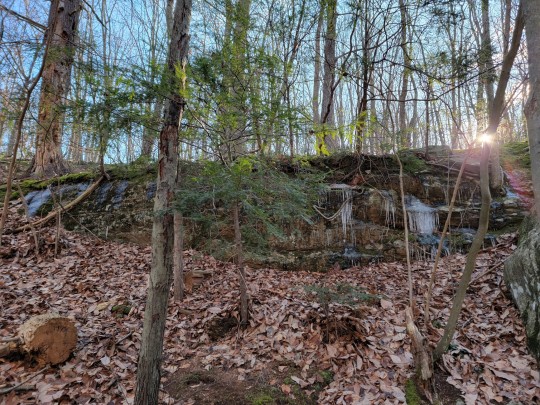
You can always find young ones in interesting locations if you know where to look! (Snag of a big one on the top left)
3 notes
·
View notes
Text

Eastern Hemlock cone (and yes that is Woolly Adelgid)
5 notes
·
View notes
Text
Tiny Beetle Provides Hope for Hemlocks | N.C. Cooperative Extension
Across western North Carolina, the dead remnants of many giant hemlock trees still stand. A majority of these trees met their demise in the early 2000s, when hemlock woolly adelgid (Adelges tsugae) made its way up and down the eastern seaboard. As a result of this rampant spread, populations of Eastern (Tsuga canadensis) and Carolina …
— Read on ashe.ces.ncsu.edu/2022/02/laricobius_survey/
View On WordPress
0 notes
Text
Preserving Majesty: Eastern Hemlock Care by NS Tree Preservation Co.
Discover the art of nurturing Eastern Hemlock trees with NS Tree Preservation Co. Our expert arborists specialize in comprehensive care, from soil enrichment to pest management. Ensure the longevity and vitality of your majestic hemlocks. Trust NS Tree Preservation Co. to safeguard the beauty of your landscape with our dedicated Eastern Hemlock preservation services.
0 notes
Text
1 note
·
View note
Text




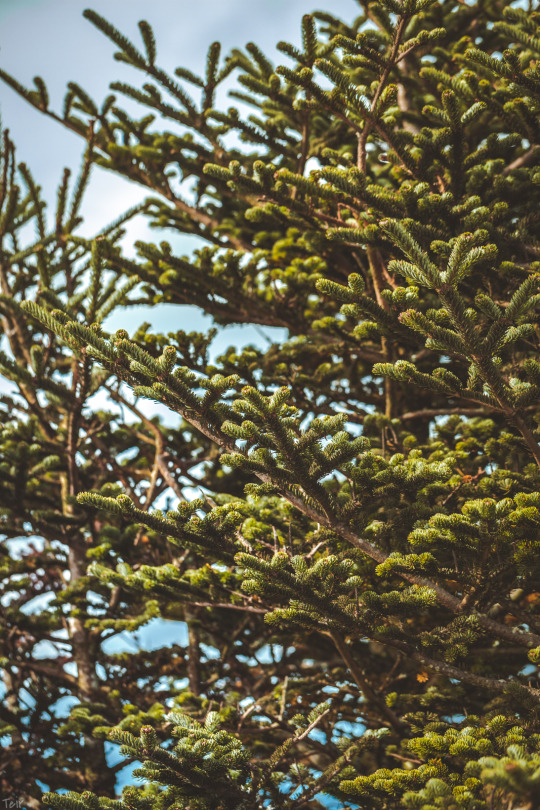
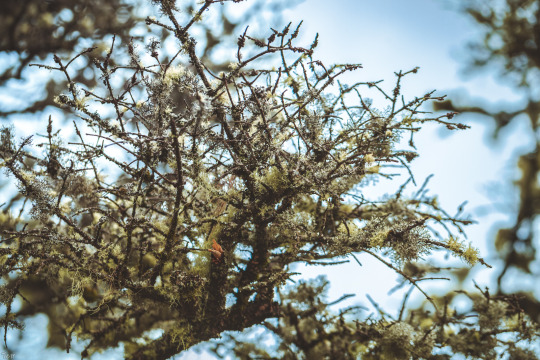
The road to Clingmans Dome is closed seasonally (for the winter months), so we weren't able to visit when we were in the area in February. Not the case this time though.
I was much more fascinated with the unique flora to the area than the views, to be completely honest. The highest elevations around the Smokies are spruce-fir forest, predominantly red spruce and Fraser fir, the latter of which is endangered and is being destroyed by the invasive balsam woolly adelgid. These are considered coniferous rainforests, and the biodiversity is incredibly rich. Ice age climates pushed boreal species much further south than their usual range, and a lot of them persisted in these higher elevations. A neat current example, which I did not know until I saw an absolute shit ton of them, are dark-eyed juncos. They appear in the backyard here in north AL to overwinter, and spend their summers far north in Canada and up into the arctic. They live year-round through the peaks of the Appalachians though! They were a friendly surprise.
Conservation efforts for the Fraser fir and other at-risk flora are making progress at slowing the damage, but the sheer amount of dead snags hurts to look at. Some of them harbored some pretty incredible moss and lichen growth though.
Hemlocks are also being effected by the hemlock woolly adelgid, which is a problem we're dealing with in north AL as well. I believe the land trust just had a meeting about it recently. Within our lifetime though, we may no longer have eastern hemlock here.
#photography#my photography#nature#Clingmans Dome#coniferous rainforest#forest#autumn#fall#red spruce#fraser fir
16 notes
·
View notes
Text
Mysterious, Mortal Bug Unveiled: Discover the Threat to Hemlock Trees in Halifax!
Halifax Region Confirmed to Have Hemlock Woolly Adelgid Infestation for the First Time
The Halifax region has recently confirmed the presence of the Hemlock Woolly Adelgid (HWA), an invasive insect species that poses a significant threat to hemlock trees. Ron Neville, a representative from the Canadian Food Inspection Agency (CFIA), described the HWA as an insect that attacks the base of tree…
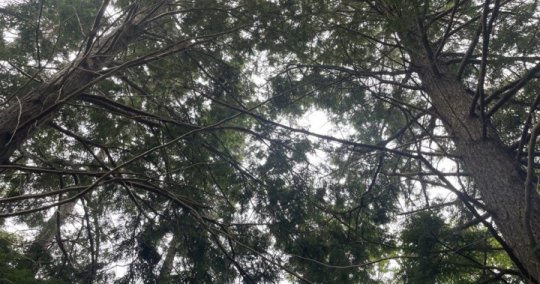
View On WordPress
0 notes